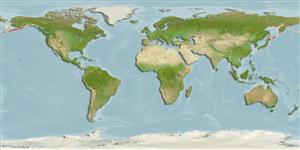Environment: milieu / climate zone / depth range / distribution range
Ecology
Marine; demersal; depth range 10 - 50 m (Ref. 50610). Boreal
Pacific Ocean: western Bering Sea of Cape Olyutorskiy; Aleutian Islands and eastern Bering Sea at Pribilof Islands.
Size / Weight / Age
Maturity: Lm ? range ? - ? cm
Max length : 5.1 cm SL male/unsexed; (Ref. 43939)
Short description
Identification keys | Morphology | Morphometrics
Dorsal spines (total): 9; Dorsal soft rays (total): 17 - 19; Anal spines: 0; Anal soft rays: 14 - 15. Pink in color; broad dusky bands extending to lateral line, one below spinous dorsal, three below soft dorsal, one on caudal peduncle, all with narrow bars extending ventrally from and between them (Ref. 43939). Caudal fin rounded.
Inhabits rocky bottoms; found among rocks covered with calcareous algae, kelp and other brown algae, and sea urchins (Ref. 43939).
Life cycle and mating behavior
Maturity | Reproduction | Spawning | Eggs | Fecundity | Larvae
Mecklenburg, C.W., T.A. Mecklenburg and L.K. Thorsteinson, 2002. Fishes of Alaska. American Fisheries Society, Bethesda, Maryland. xxxvii +1037 p. (Ref. 43939)
IUCN Red List Status (Ref. 130435: Version 2024-2)
Threat to humans
Harmless
Human uses
Tools
Special reports
Download XML
Internet sources
Estimates based on models
Preferred temperature (Ref.
123201): 1.6 - 6.4, mean 4 °C (based on 52 cells).
Phylogenetic diversity index (Ref.
82804): PD
50 = 0.6250 [Uniqueness, from 0.5 = low to 2.0 = high].
Bayesian length-weight: a=0.00955 (0.00344 - 0.02648), b=3.09 (2.85 - 3.33), in cm total length, based on LWR estimates for this (Sub)family-body shape (Ref.
93245).
Trophic level (Ref.
69278): 3.2 ±0.5 se; based on size and trophs of closest relatives
Resilience (Ref.
120179): High, minimum population doubling time less than 15 months (Preliminary K or Fecundity.).
Fishing Vulnerability (Ref.
59153): Low vulnerability (10 of 100).
